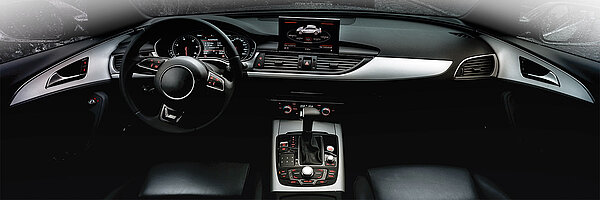Demanding Both Reliability and Flexibility
The material mix in the car and the different environmental influences make high demands on the adhesives. Temperature fluctuations and changing media influences call for increased performance of the adhesives and their properties. While reliability is crucial, the flexibility of the adhesives also matters, since too much heat may cause embrittlement. Modified acrylates are particularly suitable in this case and allow joining of plastics such as PC / ABS.
Another aspect is that the adhesives’ glass transition temperature lies at –65 °C. This means that they remain flexible in the automotive interior with service temperatures ranging from –40 °C to +100 °C, as they will only become brittle below the glass transition temperature. Adhesives can also be fluorescent, which is very useful for dispensing control in production lines. With a service temperature range from +120 °C to +150 °C, the modified acrylates remain flexible event at high temperatures.
The dashboard, in particular, needs to have an attractive look and feel. But it's not just the optical aspect that matters, it's the quality as well. That is why decorative and ornamental elements such as chrome rings around ventilation slots, moldings in real wood on doors and on steering wheels, as well as cladding for radios, for example, are fixed by bonding.
The reason is simple: In contrast to screws, adhesives are invisible, and they are more reliable than snap hooks. Adhesives easily withstand temperature fluctuations and even the associated expansion of the materials. Furthermore, as proved by tests, they provide additional safety. Head-on crash tests have revealed that clipped decorative elements may break or splinter in the event of an accident. The protruding plastic material thus presents a potential risk of injury to the occupants. However, if these elements are attached by bonding, this risk can be prevented and broken chrome rings remain in their position during an impact.
Adhesive Tapes Versus Adhesives
As an alternative, pressure-sensitive adhesive tapes may also be used for fixing decorative elements in the car. These have the advantage of fast processing, since they adhere immediately and thus directly reach their final strength. They are primarily used for emblem bonding, for example on the steering wheel or the car key. As the tapes are small, invariable, and point-shaped due to the production process, it makes sense to use them for this kind of application. More complex shapes, however, as needed for bonding of frames around displays, for example, make the use of tapes expensive. Tapes of such dimensions are much too delicate to be handled by machines. As a consequence, they would have to be adjusted and applied manually, which would significantly increase production costs.
Using Light for Faster Bonding
Decorative elements are often made of opaque materials, such as dark plastics or chrome. This makes curing only with light impossible. But, of course, the automotive industry seeks to achieve short cycle times and high production numbers, and that is why one-component epoxy resins are used in this case. They can be very quickly preactivated by light.
The special feature of preactivation is that the adhesive still remains liquid after a short irradiation time, allowing the above-mentioned opaque components to be joined as well. During this period of preactivation, which is called “open time”, the components can still be adjusted. After the open time, the adhesive cures within a few minutes without light influence. Curing can then be accelerated by additional heat input. This means that the process takes place in the following order: dispensing the adhesive, irradiating it, and joining the components. One-component adhesives also have the advantage of being more easily dispensed and processed than two component adhesives. Epoxy resins are particularly suitable for bonding materials such as PC, PPS, or chrome-plated surfaces. They are characterized by low outgassing, high reliability, and resistance to temperatures and media.
Conclusion
When bonding decorative elements, it is important that the adhesives cure quickly, even in fully automated production processes, and that high throughput can be achieved. Rapid final curing and the possibility to be dispensed in very small quantities are therefore essential properties. The adhesives presented here furthermore allow individual adjustment to the specific needs of the different points of application. In contrast to other joining methods, they are flexible and reliable all-rounders when it is important to maintain the appearance of decorative elements in the car.








